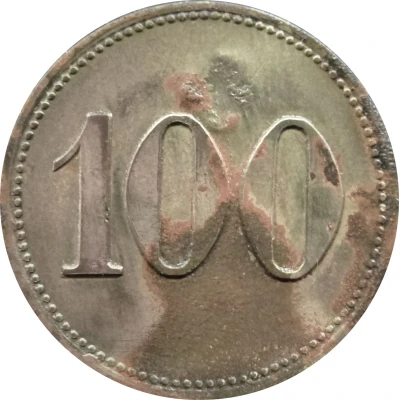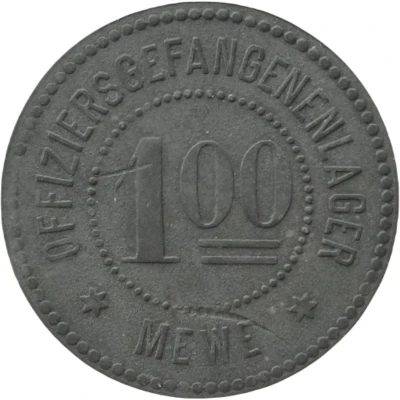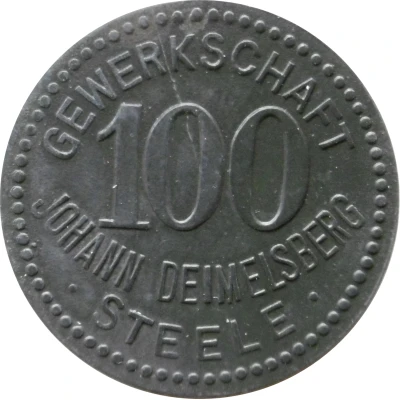


© Willem63 (CC BY-NC-SA)
100 Pfennigs - Wahmbeck (Rothhaus) ND
| Brass | 2.8 g | 23.3 mm |
| Location | German notgeld (Germany) |
|---|---|
| Type | Trade tokens › Internment or prison tokens |
| Value | 100 Pfennigs (100 Pfennige) |
| Currency | Mark (1914-1924) |
| Composition | Brass |
| Weight | 2.8 g |
| Diameter | 23.3 mm |
| Thickness | 1.0 mm |
| Shape | Round |
| Orientation | Medal alignment ↑↑ |
| Demonetized | Yes |
| Updated | 2024-11-14 |
| Numista | N#311430 |
|---|---|
| Rarity index | 100% |
Reverse
Pearl rim, with denomination centered
Script: Latin
Lettering: 100
Edge
Plain
Comment
Menzel: CCCThe camp was located on the grounds of the "Sommerfrische Rothhaus" hotel in Wahmbeck an der Weser, which was converted into a camp by prisoners of war in May / June 1915. The construction of the camp thus fell at the end of the early phase (1914/1915) of the German camp development, when prisoners of war were temporarily housed in empty buildings. The construction of the prison camp brought considerable changes for Wahmbeck, so a line was laid from neighboring Lippoldsberg to supply the camp with electricity, which meant electrification of the village. During the war, only officers (and a few ordinaries) were held prisoner in the Wahmbeck camp, although according to the available sources the camp never had more than 150 prisoners. Immediately after the camp was established, there were mainly Russian and French officers in Wahmbeck, from 1917 mainly British. In contemporary German propaganda, Wahmbeck was transfigured as a model camp for "officers in need of recovery and sick officers". In fact, living conditions were very cramped in the camp, which neutral inspectors repeatedly brought up when they visited the camp. Administratively, the Wahmbeck camp was under the direction of the Deputy General Command of the X Army Corps. In 1915, the camp management on site comprised a captain (officer), four non-commissioned officers, 24 guards and some military camp officials.
After the fall of the monarchy in the German Reich, the situation in the Wahmbeck camp remained comparatively calm. A soldiers 'council in Wahmbeck formed in the course of the November Revolution saw itself as a guarantor of order and intervened in the dismissal of a soldiers' council in the neighboring district town of Uslar. At the same time, members of the Wahmbeck Soldiers' Council took part in public events in Uslar against the idea of a soviet republic and advocated elections to a national assembly.
Meanwhile, after the Compiègne armistice, the camp continued to be used. At first it was used to detain Russian prisoners of war whose repatriation was prohibited by the armistice treaty. From 1920 it provided quarters for Russian civilians who had fled to Germany as a result of the Russian Revolution. In this function, the camp continued to exist until March 1, 1922.



